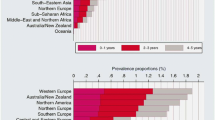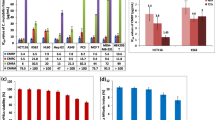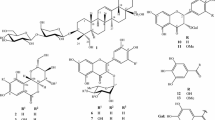Abstract
Njavara is an important medicinal rice variety of Kerala, India widely used in Ayurveda for the treatment of rheumatoid arthritis, paralysis, neurodegenerative diseases and in rejuvenation therapy. The study evaluated, for the first time, antitumor effects of the two rare flavonolignans, tricin 4′-O-(erythro-β-guaiacylglyceryl) ether (compound 1) and tricin 4′-O-(threo-β-guaiacylglyceryl) ether (compound 2), isolated from ‘Njavara’ black. Both the compounds induced apoptosis in three cancer cell lines colon adenocarcinoma cell line HCT 116, ovarian cancer cell line SKOV3 and breast cancer cell line MCF-7. Chromatin condensation in the three cancer cell lines by Hoechst staining showed >50 % of apoptosis by compounds 1 and 2 at concentration 40 and 30 μg/ml, respectively after 48 h. Further studies substantiated that both the compounds targeted cancer cells through mitochondrial membrane potential loss and subsequent chromatin condensation. Both compounds significantly increased the Annexin V binding thus confirming compounds 1 and 2 to be potential apoptotic agents.




Similar content being viewed by others
References
Kerr JFR, Winterford CM, Harmon BV (1994) Apoptosis: its significance in cancer and cancer therapy. Cancer 73:2013–2026
Hengartner MO (2000) The biochemistry of apoptosis. Nature 407:770–776
Harada H, Grant S (2003) Apoptosis regulators. Rev Clin Exp Hematol 7:117–138
Ghobrial IM, Witzig TE, Adjei AA (2005) Targeting apoptosis pathways in cancer therapy. CA Cancer J Clin 55:178–194
Pan MH, Ho CT (2008) Chemopreventive effects of dietary compounds on cancer development. Chem Soc Rev 37:2558–2574
Cragg GM, Newman DJ (2009) Nature: a vital source of leads for anticancer drug development. Phytochem Rev 8:313–331
Tansuwanwong S, yamamoto H, Imai K, Viniketkumnuen U (2009) Antiproliferation and apoptosis on RKO colon cancer by Millintonia hortensis. Plant Foods Hum Nutr 64:11–17
Mohanlal S, Parvathy R, Shalini V, Helen A, Jayalekshmy A (2011) Isolation, characterisation and quantification of tricin and flavonolignans in the medicinal rice Njavara (Oryza sativa L.) as compared to staple varieties. Plant Foods Hum Nutr 66:91–96
Rao AS, Reddy SG, Babu PP, Reddy AR (2010) The antioxidant and antiproliferative activities of methanolic extracts from Njavara rice bran. BMC Complement Altern Med 10:4
Hudson EA, Dinh PA, Kokubun T, Simmonds MSJ, Gescher A (2000) Characterization of potentially chemopreventive phenols in extracts of brown rice that inhibit the growth of human breast and colon cancer cells. Cancer Epidemiol Biomarkers Prev 9:1163–1170
Karunagaran D, Rashmi R, SanthoshKumar TR (2005) Induction of apoptosis by curcumin and its implications for cancer therapy. Curr Cancer Drug Targ 5:117–129
Sahai M, Harle J, Begum SA, Ray AB (2010) Nonconventional lignans: coumarinolignans, flavonolignans and stilbenolignans. Fortschritte der Chemie organischer Naturstoffe. Prog Chem Org Nat Prod (Progrès dans la chimie des substances organiques naturelles) 93:1–70
Dixit N, Baboota S, Kohli K, Ahmed S, Ali J (2007) Silymarin: a review of pharmacological aspects and bioavailability enhancement approaches. Indian J Pharmacol 39:172–179
Duan W, Jin X, Li Q, Tashiro SI, Onodera S, Ikejima T (2010) Silibinin induced autophagic and apoptotic cell death in HT1080 cells through a reactive oxygen species pathway. J Pharmacol Sci 113:48–56
Syrchina AI, Gorshkov AG, Shcherbakov VV, Zinchenko SV, Vereshchagin AL, Zaikov KL, Semenov AA (1992) Flavonolignans of Salsola collina. Khim Prir Soed 2:182–186 (Engl. Trans. Chem Nat Compd 28: 155–158)
Bouaziz M, Veitch NC, Grayer RJ, Simmonds MSJ, Damak M (2002) Flavonolignans from Hyparrhenia hirta. Phytochemistry 60:515–520
Wenzig E, Kunert O, Ferreira D, Schimid M, Schuhly W, Bauer R, Hiermann A (2005) Flavonolignans from Avena sativa. J Nat Prod 68:289–292
Chang C, Zhang L, Chen RY, Kuo LY, Huang J, Huang H, Lee K, Wu Y, Kuo Y (2010) Antioxidant and anti-inflammatory phenylpropanoid derivatives from Calamus quiquesetinervius. J Nat Prod 73:1482–1488
Chang C, Wang G, Zhang L, Tsai W, Chen R, Wu Y, Kuo Y (2010) Cardiovascular protective flavonolignans and flavonoids from Calamus quiquesetinervius. Phytochemistry 71:271–279
Crompton M (1999) The mitochondrial permeability transition pore and its role in cell death. Biochem J 341:233–249
Elmore S (2007) Apoptosis: a review of programmed cell death. Toxicol Pathol 35:495–516
Acknowledgments
The authors (SM and AJ) are grateful for the funding assistance provided by Kerala State Council for Science, Technology and Environment (KSCSTE), Government of Kerala. The author (SM) wishes to thank Council of Scientific and Industrial Research (CSIR), India for the financial support as Senior Research Fellowship (SRF). Thanks are also due to Director, CSIR-NIIST and Director, Rajiv Gandhi Centre for Biotechnology (RGCB) for constant encouragement and support.
Author information
Authors and Affiliations
Corresponding author
Electronic supplementary material
Below is the link to the electronic supplementary material.
Rights and permissions
About this article
Cite this article
Mohanlal, S., Maney, S.K., Santhoshkumar, T.R. et al. Tricin 4′-O-(erythro-β-guaiacylglyceryl) ether and tricin 4′-O-(threo-β-guaiacylglyceryl) ether isolated from Njavara (Oryza sativa L. var. Njavara), induce apoptosis in multiple tumor cells by mitochondrial pathway. J Nat Med 67, 528–533 (2013). https://doi.org/10.1007/s11418-012-0710-7
Received:
Accepted:
Published:
Issue Date:
DOI: https://doi.org/10.1007/s11418-012-0710-7




